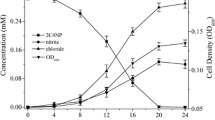Abstract
An Alcaligenes denitrificans strain capable of utilizing theherbicide (R)-(+)-2(2-methyl-4-chlorophenoxy)propionicacid (mecoprop) as a sole carbon source was isolated fromsoil and cultured in liquid medium. Crude cell extracts of thebacterium were utilized in spectrophotometric assays toelucidate a biochemical pathway for degradation ofmecoprop. Results indicated a reaction sequence analogousto the degradation of 2,4-dichlorophenoxyacetic acid (2,4-D).GC-MS analysis provided direct evidence for thebiotransformation of mecoprop to the transient metabolite4-chloro-2-methylphenol (MCP). No NADPH-dependentactivity was observed during this reaction. Pyruvate wasverified as the second product derived from the aliphatic sidechain of mecoprop. MCP was subsequently transformed to asubstituted catechol by an NADPH-dependentmonooxygenase. When grown on mecoprop, A.denitrificans was adapted to oxidize catechol and its 4- and3-methylated derivatives indicating the broad substratespecificity of catechol dioxygenase. The microorganism wasdemonstrated to adopt the ortho mechanism of aromaticcleavage which resulted in the formation of2-methyl-4-carboxymethylene but-2-en-4-olide, a reactionintermediate of the β-ketoadipate pathway.
Similar content being viewed by others
References
Abbott MT & Udenfriend S (1974) Ketoglutarate-coupled dioxygenases. In: Hayaishi O (ntEd) Molecular Mechanisms of Oxygen Activation (pp 167–214). Academic Press, London
Anonymous (1992) Produce Farmstat Survey
Bollag JM, Helling CS & Alexander M (1967) Metabolism of 4-chloro-2-methylphenoxyacetic acid by soil bacteria.Appl.Microbiol. 15: 1393–1398-(1968a) 2,4-D metabolism: enzymatic hydroxylation of chlorinated phenols. J. Agr. Food Chem. 16: 826–828
Bollag JM, Briggs GG, Dawson JE & Alexander M (1968b) 2,4-D metabolism: enzymatic degradation of chlorocatechols. J. Agr. Food Chem. 16: 829–833
Chaudhry GR & Chapalamadugu S (1991) Biodegradation of halogenated organic compounds. Microbiol. Rev. 55: 59–79
Commandeur LCM & Parsons JR(1990) Degradation of halogenated aromatic compounds. Biodegradation 1: 207–220
Dagley S (1987) Lessons from biodegradation. Annu. Rev. Microbiol. 41: 1–23
Evans WC, Smith BSW, Moss P & Fernley HN (1971a) Bacterial metabolism of 4-chlorophenoxyacetate. Biochem. J. 122: 509–517
Evans WC, Smith BSW, Fernley HN & Davies JI (1971b) Bacterial metabolism of 2,4-dichlorophenoxyacetate. Biochem. J. 122: 543–552
Fukumori F & Hausinger RP (1993) Alcaligenes eutrophusJMP134 '2,4-dichlorophenoxyacetate monooxygenase' is an ketoglutarate-dependent dioxygenase. J. Bacteriol. 175: 2083–2086
Gamar Y & Gaunt JK (1971) Bacterial metabolism of 4-chloro-2-methylphenoxyacetate (MCPA): formation of glyoxylate by side-chain cleavage. Biochem. J. 122: 527–531
Gaunt JK & Evans WC (1971a) Metabolism of 4-chloro-2-methylphenoxyacetate by a soil pseudomonad: Preliminary evidence for the metabolic pathway. Biochem. J. 122: 519–526-(1971b) Metabolism of 4-chloro-2-methylphenoxyacetate by a soil pseudomonad. Ring-fission, lactonizing and delactonizing enzymes. Biochem. J. 122: 533-542
H¨aggblom MM (1992) Microbial breakdown of halogenated aromatic pesticides and related compounds. FEMS Microbiol. Rev. 103: 29–72
Haigler BE, Nishino SF & Spain JC (1988) Degradation of 1, 2-dichlorobenzene by aPseudomonassp.Appl. Environ.Microbiol. 54: 294–300
Hegeman GD (1966) Synthesis of the enzymes of the mandelate pathway by Pseudomonas putida. J. Bacteriol. 91: 1140–1154
Higson FK & Focht DD (1992) Utilization of 3-chloro-2-methylbenzoic acid by Pseudomonas cepaciaMB2 through the metafission pathway. Appl. Environ. Microbiol. 58: 2501–2504
Kilby (1948) The bacterial oxidation of phenol to α-keto-adipic acid. Biochem. J. 43: V–VI
Kilpi S (1980) Degradation of some phenoxy acid herbicides by mixed cultures of bacteria from soil treated with 2-(2-methyl-4-chloro)phenoxypropionic acid. Microbial Ecol. 6: 261–270
Lindholm L, Backstr¨om V & Kilpi S (1982) Degradation of mecoprop in soil. Acta Agr. Scandinavica 32: 429–432
Loos MA, Roberts RN & Alexander M(1967a) Phenols as intermediates in the decomposition of phenoxyacetates by an Arthrobactersp. Canadian J. Microbiol. 13: 679–690-(1967b) Formation of 2,4-dichlorophenol and 2,4-dichloroanisole from 2,4-dichlorophenoxyacetate by Arthrobactersp. Canadian J. Microbiol. 13: 691–699
Loos MA (1975) Phenoxyalkanoic acids. In: Kearney PC & Kaufman DD (Eds) Herbicides: Their Chemistry, Degradation and Mode of Action, Vol 1 (pp 34-57). Marcel Dekker, New York
MacRae IC, Alexander M & Rovira AD (1963) The decomposition of 4-(2, 4-dichlorophenoxy)butyric acid by Flavobacteriumsp. J. Gen. Microbiol. 32: 69–76
Oh K & Tuovinen OH (1991a) Bacterial degradation of phenoxy herbicide mixtures 2,4-D and MCPP. Bull. Environ. Contam. Toxicol. 47: 1–8-(1991b) Detection and identification of substituted phenols as intermediates of concurrent bacterial degradation of the phenoxy herbicides MCPP and 2,4-D. Microbiol. Lett. 79: 141–146-(1994) Biodegradation of the phenoxy herbicides MCPP and 2,4-D in fixed-film column reactors. Int. Biodet. Biodeg. 33: 93–99
Ornston LN & Stanier RY (1966) The conversion of catechol and protocatechuate to β-ketoadipate by Pseudomonas putida. J. Biol. Chem. 241: 3776–3785
Pandell AJ (1976) Enzyme-like aromatic oxidations. Metalcatalysed peracetic acid oxidation of phenol and catechol to cis, cismuconic acid. J. Org. Chem. 41: 3992–3996
Pieper DH, Stadlerfritzsche K, Engesser KH, Knackmuss HJ (1993) Metabolism of 2-chloro-4-methylphenoxyacetate by Alcaligenes eutrophusJMP-134. Arch. Microbiol. 160: 169–178
Sandmann E & Loos MA (1988) Aromatic metabolism of a 2,4-D degrading Arthrobactersp. Canadian J. Microbiol. 34: 125–130
Schl¨omann M (1994) Evolution of chlorocatechol catabolic pathways. Biodegradation 5: 301–321
Sinton GL, Fan LT, Erickson LE & Lee SM (1986) Biodegradation of 2,4-D and related xenobiotic compounds. Enzyme Microbial Technol. 8: 395–403
Stanier RY, Palleroni NJ & Doudoroff M (1966) The aerobic pseudomonads: a taxonomic study.J. Gen. Microbiol. 43: 159–271
Tett VA, Willetts AJ & Lappin-Scott HM (1994) Enantioselective degradation of the herbicide mecoprop [2-(2-methyl-4-chlorophenoxy)propionic acid] by mixed and pure bacterial cultures. FEMS Microbiol. Ecol. 14: 191–200
Tiedje JM & Alexander M (1969) Enzymatic cleavage of the ether bond of 2,4-dichlorophenoxyacetate. J. Agr. Food Chem. 17: 1080–1084
Tiedje JM, D uxbury JM, Alexander M & Dawson JE (1969) 2,4-D metabolism: pathway of degradation of chlorocatechols by Arthrobactersp. J. Agr. Food Chem. 17: 1021–1026
Worsey MJ & Williams PA (1975) Metabolism of toluene and xylenes by Pseudomonas putida(arvilla) mt-2: evidence for a new function of the TOL plasmid. J. Bacteriol. 124: 7–13
Worthing CR & Walker SB (1991) The Pesticide Manual: A World Compendium. BCPC Publications, Bracknell, UK
Author information
Authors and Affiliations
Rights and permissions
About this article
Cite this article
Tett, V.A., Willetts, A.J. & Lappin-Scott, H.M. Biodegradation of the chlorophenoxy herbicide (R)-(+)-mecoprop by Alcaligenes denitrificans. Biodegradation 8, 43–52 (1997). https://doi.org/10.1023/A:1008262901202
Issue Date:
DOI: https://doi.org/10.1023/A:1008262901202




